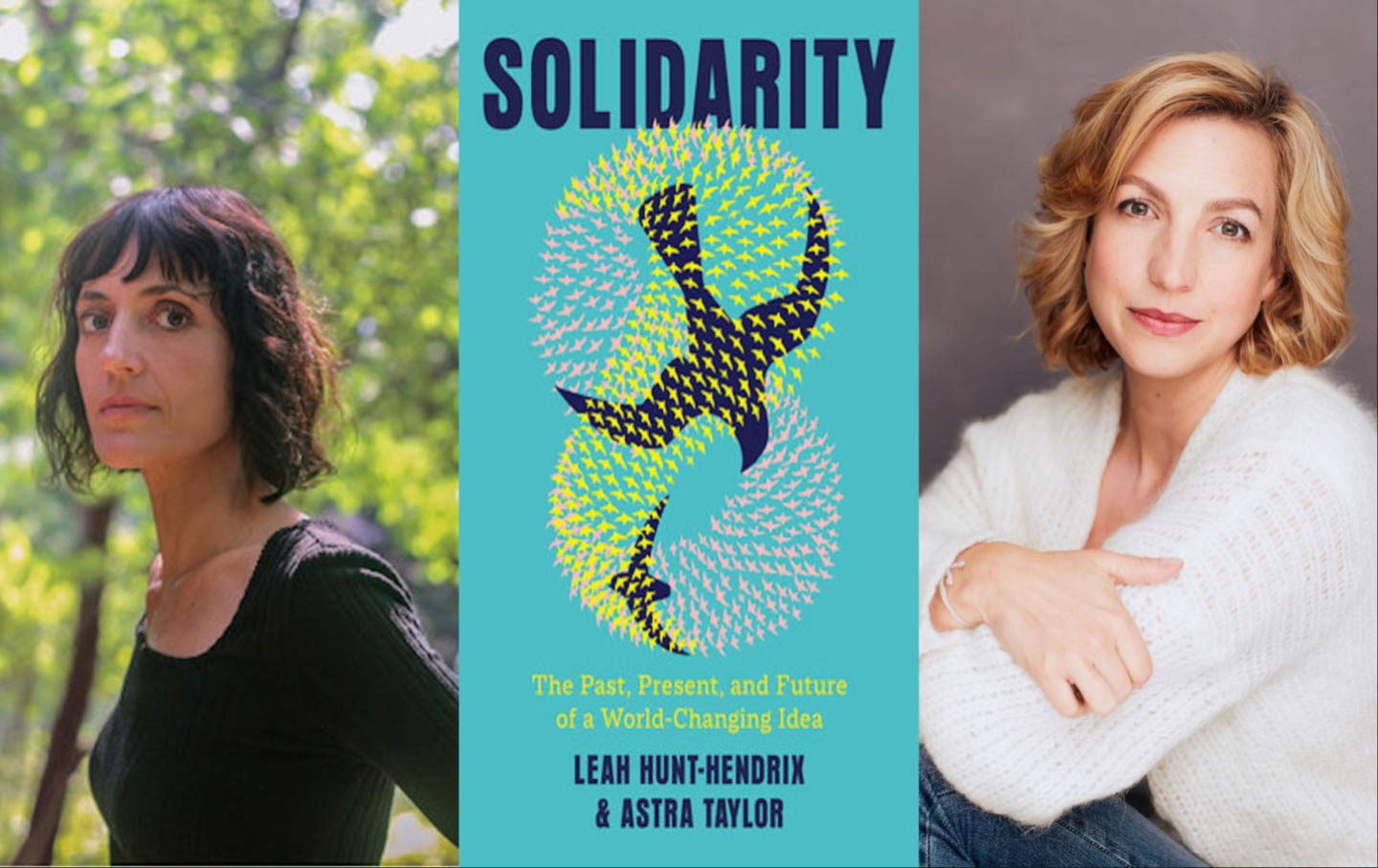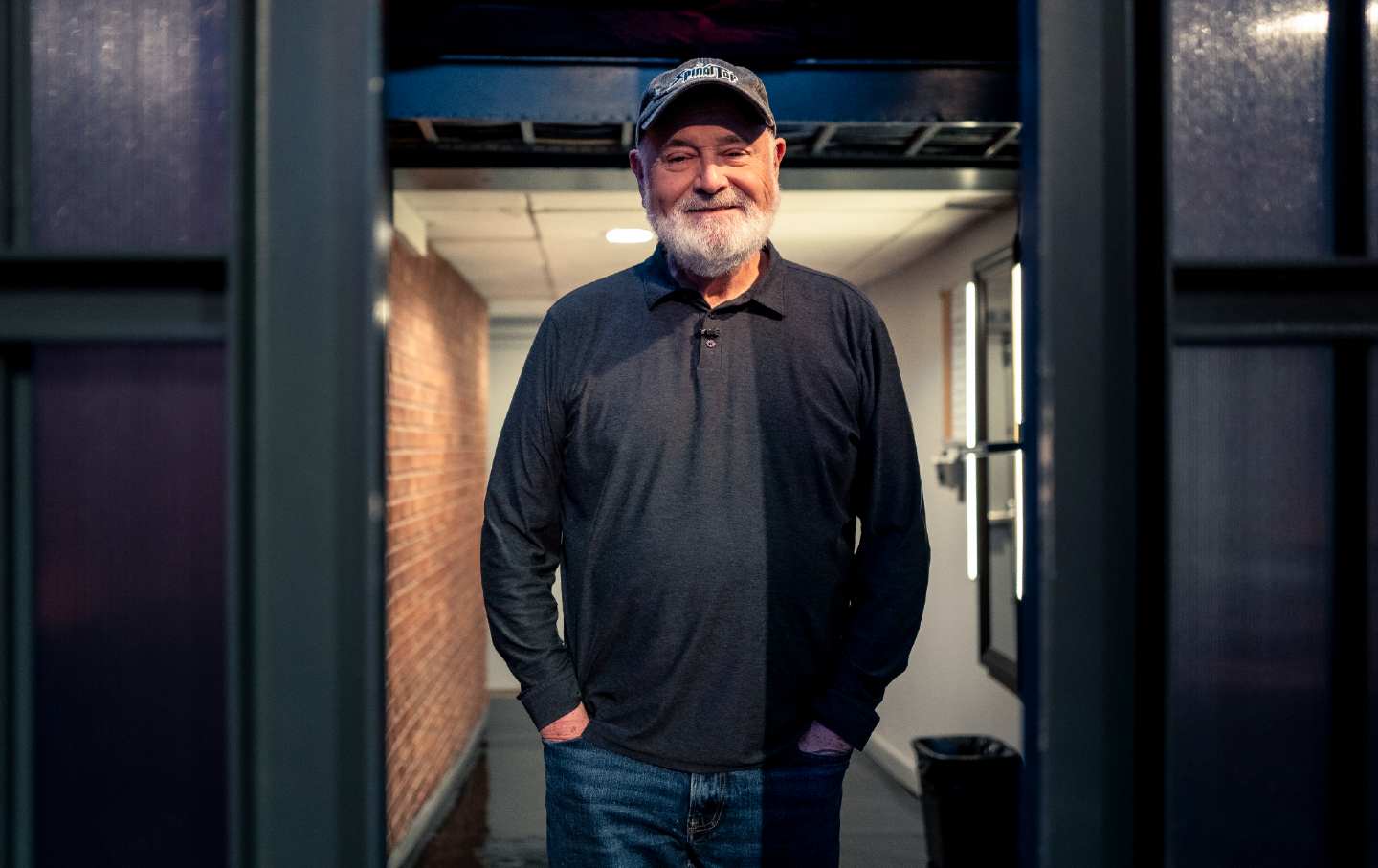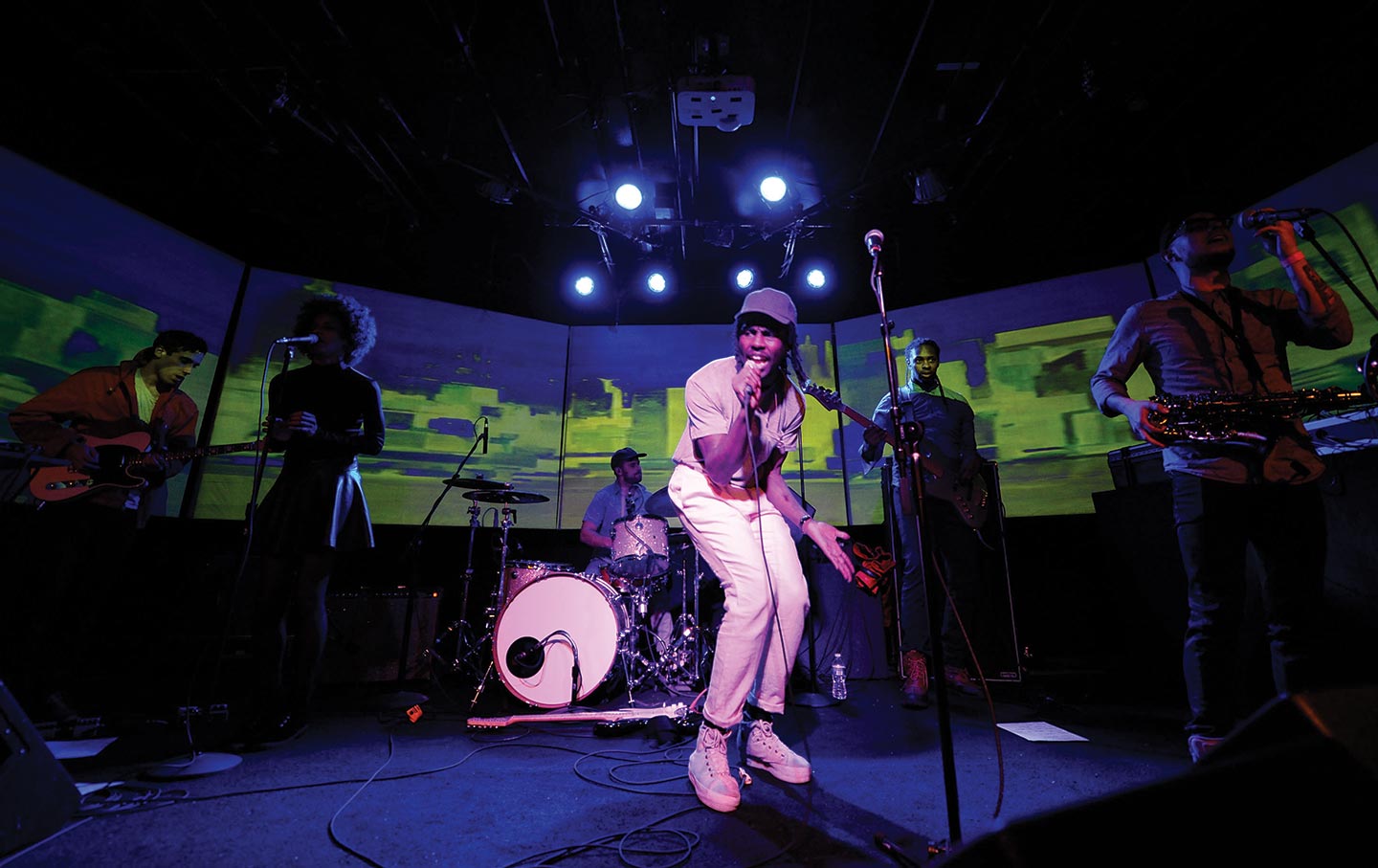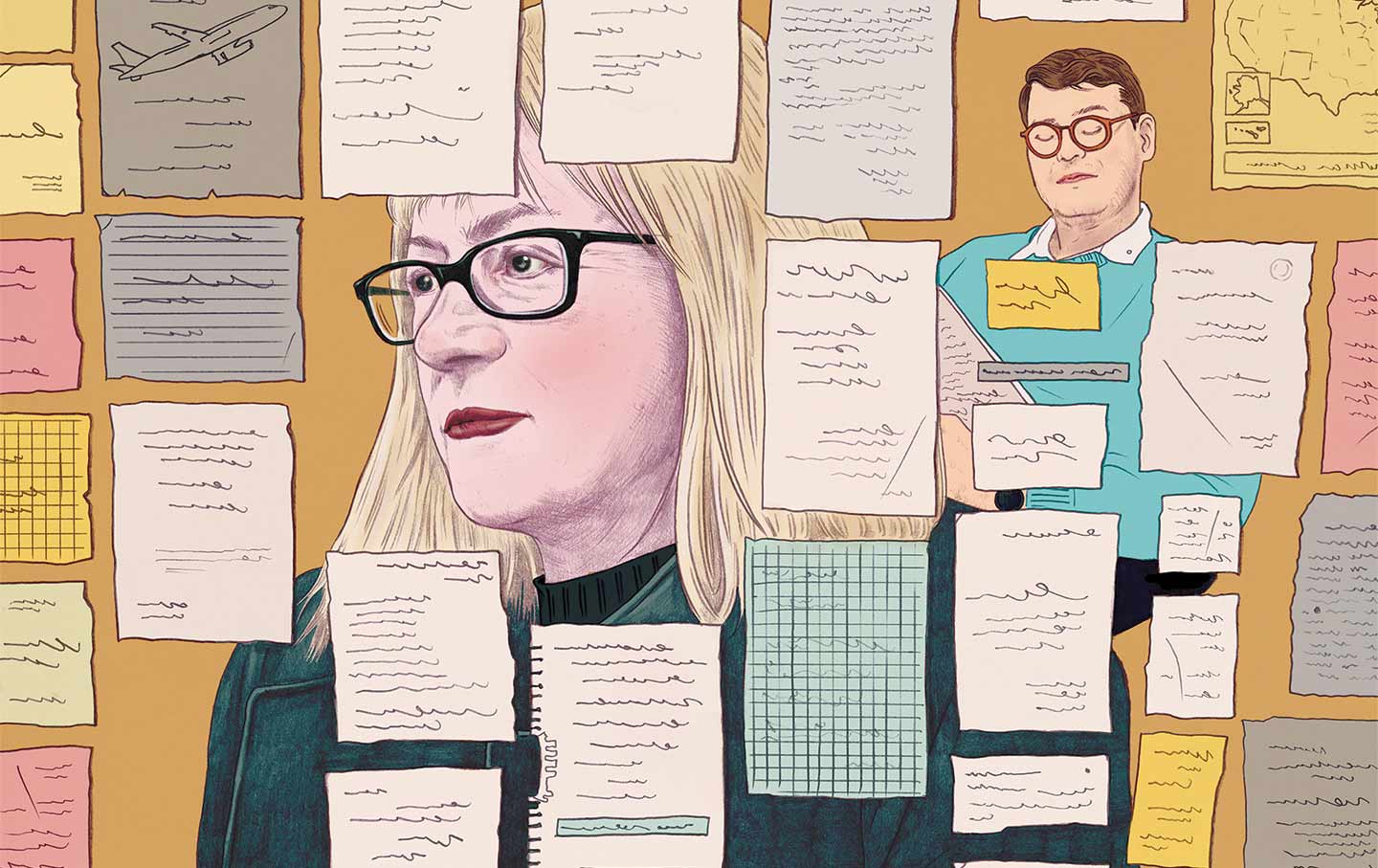Talking “Solidarity” With Astra Taylor and Leah Hunt-Hendrix
A conversation with the activists and writers about their wide-ranging history of the politics of the common good and togetherness.

The notion of “solidarity” has a rich intellectual history that—outside of left-leaning circles—remains marginal to mainstream American cultural and political discourse. This is perhaps due in part to the American liberal tradition’s emphasis on individual rights, in contrast to the French historical tradition that can be traced back to that country’s revolutionary emphasis on equality and fraternity. But if there was ever a time for an American audience to become familiar with solidarity’s deep history, it would be now. An epidemic of loneliness, staggering inequality, forever wars, environmental degradation are just a small sample of the current problems we can only face together, not alone.
It is for these reasons and more that the new book Solidarity: The Past, Present and Future of a World-Changing Idea, by the organizers and theorists Leah Hunt-Hendrix and Astra Taylor, proves so timely. They provide readers not only with a history of solidarity that goes as far back as ancient Rome and all the way up to 21st-century protest movements such as Occupy Wall Street and Black Lives Matter, but also with good guidance on how solidarity can be built and sustained in order to overcome the many crises of the present moment.
The Nation spoke with Hunt-Hendrix and Taylor about their new book, the role that solidarity plays in left-wing and right-wing movements, and how what they describe as “transformative solidarity” on the left can counter the right while offering principles and practices for the common good in political and social life.
—Daniel Steinmetz-Jenkins
Daniel Steinmetz-Jenkins: Your book is ambitious. Not only do you seek to provide readers with a history of the idea of solidarity from antiquity to the present, but you also offer a guide for how solidarity can be built and sustained in a world marked by growing inequality, war, and ecological catastrophe. Given these aims, what do you see as the defining features of solidarity, and which model of it do you favor?
Leah Hunt-Hendrix: We see solidarity as a concept that is central to the possibility of democracy, on par with ideals like freedom and equality. It is a concept that conveys how we hold together and create bonds that facilitate collective action. But despite its importance, it has not been given the attention that other, similar political concepts have received. There are many reasons for this, but one is solidarity’s complexity, the many senses in which it has been used. Solidarity is a concept that can inform our thinking about the economy and the state, as well as social movements and society more broadly. The model we are most interested in is the one in which solidarity presents itself as an alternative to unity or sameness, and offers a way of bridging differences to create new collective identities.
Astra Taylor: Our book lays out a vision of transformative solidarity, the kind of solidarity that connects people across differences and aims at social change. We argue that this kind of solidarity should be both a means and an end—both the key to forging powerful, strategic, and effective social movements and something that defines the kind of social and political reality it would be worth trying to create.
DS: You contrast “transformative solidarity” with what you call “reactionary solidarity.” In light of this latter notion, would you say that the right today is actually better at practicing solidarity than the left, especially given how many elections right-wing nationalists around the globe are winning? What is the lesson that needs to be learned from this?
LHH: Both forms of solidarity take intentional construction, and both involve telling a story about who is the “us” and who is the “them.” The right has been good at this because reactionary solidarity is easier to build than its transformative counterpart: It is based on exclusion, othering, creating an in-group that feels superior to (or victimized by) an out-group. Transformative solidarity requires building commonalities across differences, which is an imaginative and constructive process that takes creativity. For example, the identity of “workers” was constructed as a category that could cover bricklayers and carpenters and pipemakers during the Industrial Revolution. The disability justice movement also created a framework to unite many people with different abilities to collectively advocate for conditions that would meet their needs.
Too often, progressives and liberals want to believe that we can all just get along and so hesitate to identify our enemies. But we think the lesson to learn is that solidarity must be constructed; it is made, not given, and it does involve some form of polarization. We—those who want a world that is just and fair, and who care about our planet and climate change—face serious opposition from people who put personal profit above all else, who claim that the market should know no constraints (even as they fund politicians and policies to bend the market to their will), and who try to divide the rest of us for their own benefit. This was the framework Occupy Wall Street employed: the 99 percent versus the 1 percent, which pointed to the division between the majority of us and the plutocratic class, recently epitomized by investor Bill Ackman and his rampage against DEI, for example, or ExxonMobil’s decades-long campaign of climate denial.
So we hope the book can encourage people to think about how they participate in the construction of collective identities and how we can make those identities more inclusive, creating bigger and broader notions of “us.” But this also means identifying the right opponents.
AT: I’ll add that part of what’s interesting to me is how solidarity relates to identity and how we see and understand ourselves and others, but it isn’t the same as identity. Identity and solidarity are related but not synonymous: Solidarity transcends identity, pushes us beyond ourselves. Sometimes we take on new identities in this process—the way people began to understand themselves as part of the 99 percent during Occupy Wall Street, for example—and sometimes we don’t. I don’t necessarily need a new identity to be part of the peace movement calling for a cease-fire in the Middle East and to see myself as connected to other folks who want the same. In such cases, our identities or experiences are more like portals to connect with others and, hopefully, build power together without collapsing our differences.
We think reactionary solidarity is bad because it abets the plutocratic project of divide and conquer. When nationalists blame immigrants for social and economic troubles, it’s loathsome and morally wrong, but it’s also empirically wrong, and purposefully so. It deflects blame and stops people from looking critically at the economic interests and individuals who profit from a splintered working class. In contrast, transformative solidarity connects and empowers.
DS: It seems that the key theoretical figure in your book for understanding solidarity is the French sociologist Émile Durkheim. What is it about Durkheim’s thinking about solidarity that you find useful? I ask because some might wonder if Durkheim is a good guide for the left today. Wasn’t his conception of solidarity inseparable from bolstering French patriotism in Europe’s age of high imperialism? He was also a critic of socialists committed to class struggle.
LHH: I wouldn’t say he’s the “key”; we actually draw on many intellectual resources throughout the book. Durkheim was one of the first to really theorize about solidarity, so we discuss his work as we lay out the history of thinking about the concept, which begins most explicitly in France in the late 1800s. But we also draw on Marx, the socialist tradition, and the labor movement. We suggest that the 19th century saw the development of two contrasting notions of solidarity: Durkheim and the solidarists’, which was more focused on social cohesion, and the labor movement’s, which was more oriented toward social change. Durkheim is interesting because of the way he frames the problem in the midst of the Industrial Revolution, the decline of the monarchy and church, and the rise of suicide rates. He asks the question of how society can hang together, which is a question pertinent to today. The socialist and labor tradition, on the other hand, is more interested in how society can be transformed, and how to overcome the oppression of the owning class. We are interested in both questions and, in fact, see them as interrelated.
AT: We also draw on the thinking of 20th- and 21st-century movements. We return to the postcolonial independence movement, and later the global justice movement, both of which proposed visions for an international order based on solidarity. We lift up Frances Perkins’s role in the New Deal and the development of the International Labour Organization and more recent labor organizing. We look at the Polish Solidarity movement, in which workers, intellectuals, students, and the broader society built a social movement for democracy. We look at Ella Baker and the civil rights movement, the disability justice movement, and Occupy Wall Street as more recent examples as well. We staunchly resist the clichéd divide between “theory” and “practice” and are adamant that social movements are intellectual enterprises, and that activists and organizers are doers and also thinkers. This is fitting, given the topic—solidarity is something consciously made; it is reflection and action.
DS: One thing I found very interesting about your discussion of Durkheim is the role that the sacred played in his thinking about solidarity. Can you explain this connection and how it relates to your attempt to revive solidarity for social action on the left today? Does the left need to become more religious, in some sense, in order to forge the bonds of solidarity?
LHH: The left can tend to make its arguments in terms of data and facts. In his early work, Durkheim hoped the division of labor would create solidarity as we became aware of our economic interdependence. The Marxist tradition has also involved the hope that solidarity would emerge spontaneously among the working class. Both of these hopes have proven faulty. People are motivated by more than just economic self-interest, and we operate within stories that frame who we are and what matters. We crave a sense of meaning, and social movements do best when they tap into that—when they reach beyond pure self-interest and tell a story about what is sacred. Take the way Donald Trump has been framed as a God-like figure for his base. This is, of course, a destructive version of this logic, but it’s part of why Trump is so successful. On the other hand, we see the power of invocations of the sacred by the water protectors at Standing Rock and in Indigenous struggles against pipelines and fracking. As we organize, we can offer the facts and figures, but we need to think about the larger stories we tell, the values we embrace, the meanings we make. We believe this is a more powerful way to build solidarity.
DS: Both of you are activists, and one of the great features of this book is that it offers readers an excellent example of how you have attempted to reconcile the idea of transformative solidarity with its practice. Astra, in a nutshell, how does the Debt Collective illustrate thinking about transformative solidarity as a kind of praxis?
AT: Over a decade of this work, I’ve witnessed the incredible forging of solidarity that didn’t exist before. Before the Debt Collective, debtors were not a politicized bloc. Student-loan borrowers didn’t see themselves as having something in common with each other; they certainly weren’t in any sort of community with medical debtors or credit-card debtors or rent debtors. Obviously, we haven’t organized everyone in the country who fits into these massive categories, but we’ve certainly shifted the way huge numbers of people see themselves and how they understand their interests.
Transformative solidarity, we argue, changes the self while also aiming to change the larger society, and I’ve seen both at the Debt Collective. People are less atomized, less ashamed, less inclined to self-blame when they join our movement. And they begin to understand that they aren’t failures for taking on debt—rather, social policies have failed them, and those policies need to be radically altered. The fact that the government has even moved an inch on student debt relief—they have canceled over $140 billion at this point, despite Democratic foot-dragging and the setbacks at the Supreme Court—is a testament to the power of transformative solidarity.
DS: Leah, can you speak to solidarity as a kind of praxis as it relates to your involvement with Solidaire, which you describe as a kind of philanthropy involving radical solidarity between people from different backgrounds who have transformative political ends.
LHH: In recent years, there have been a number of critiques of philanthropy, and we share the concern that traditional philanthropy can be dominating, asserting the perspective and desires of the donor over the grantee. We also critique “effective altruism,” a more recent school of thought in philanthropy which emphasizes the calculation of lives that can be saved and directs resources accordingly, but which has little room for an understanding of history, politics, or power dynamics. Philanthropy motivated by solidarity, on the other hand, sees the giver and the recipient as bound together, part of a shared project. The grantee is seen as the protagonist and active agent, shaping strategy and goals. The donor can be part of that project but understands themself as a participant in a broader struggle rather than as the primary mover. But perhaps even more important, philanthropy in solidarity should be aimed at restructuring the economy so that unjust and anti-democratic imbalances of wealth are not generated in the first place.
DS: One question that readers will naturally have is how the kind of solidarity you promote makes sense beyond national borders. How do you imagine transformative solidarity taking place today at the level of international relations?
LHH: There tends to be a dichotomy of thought when it comes to foreign policy or international relations: either neoliberal globalization, in which markets reach beyond borders, or isolationism and nationalism, which pulls inward and tightens borders. We argue that these are two sides of the same coin: The global elite becomes more integrated transnationally while simultaneously encouraging anti-immigrant sentiment and reactionary nationalism. We propose instead that there is an alternative path forward, which we witnessed historically in postcolonial movements and the global justice movement of the last century. This framework recognizes our interdependence.
Our supply chains are connected beyond borders. So are our bodies and our lives. Climate change doesn’t care about borders; neither do pandemics. But we must also recognize that the wealth of the industrialized world was built through the exploitation of its colonies, and that much of the globe continues to suffer from this history. For example, we lift up the model of the New International Economic Order, which sought to create a global framework for economic relations that would benefit developing nations during the 1970s, but which was quashed by the United States. Prioritizing free trade was not some natural occurrence but was a political construction, privileging Western nations, and it’s important to remember that other models were and are available.
AT: Over the past century, there have been many experiments attempting to construct governments and economies in ways that do not mirror the modern Western capitalist model. In our book, for example, we present the idea for what we call a “solidarity state,” a vision that goes beyond the welfare state. Such a state would of course pursue redistribution and service provision, but in ways that prioritize institutionalizing and fostering solidarity by creating participatory structures and collective ownership and management of public goods. The thing is, we know that countries that attempt such experiments, that seriously challenge the rule of the market, face enormous pushback: Take Chile’s recent efforts to rewrite its Constitution, or Greece’s struggles with the eurozone. Capitalism, after all, is global, and there are powerful interests that have a stake in ensuring access to other nations’ human and natural resources; we trace many failed and also brutally crushed attempts to realize the progressive internationalist dream. But the fact is, the work must continue, because it is the only way we will be able to address the myriad crises we face. As for what transformative solidarity looks like today at the level of international relations, we argue for policies such as sovereign-debt cancellation and climate reparations, which would help put us into more egalitarian relationships and end extractive practices. That, in turn, would help us tackle planetary challenges together.
DS: Here, of course, the question of transformative solidarity and the wars in Ukraine and Gaza rears its head. How might solidarity help us think about how to renew the anti-war movement in this country?
LHH: At the beginning of World War I, the left in Europe and the US was extremely divided about the war. Rosa Luxemburg and Eugene Debs were two of many voices warning that the war would divide the working classes of the nations involved, who were being sent to the slaughter for the benefit of the upper classes. It’s always worth thinking about who profits from war, in whose interest it is to engage in military conflict—the defense industry, the arms trade, politicians hoping to stoke nationalist sentiment and reactionary solidarity. We have an opportunity right now to stand in solidarity for peace, and we are seeing many organizations and communities doing just that. A Land for All and Standing Together are two organizations that bring together Palestinians and Israelis to work toward peace. We see incredible solidarity in the streets here in the US, with people from all walks of life calling for a cease-fire. Solidarity is an orientation that calls us to reach beyond our narrow or national identities and toward a future that benefits us all. It is a perspective that should remind us that wars on distant shores have consequences for us at home, and that we are implicated when our government is funding the fight. We are all affected by those billions of dollars that are spent on bombs rather than schools. That’s why peace in Israel and Gaza should not be seen as a “single issue” or simply a concern for Muslims or Jews, but as something in which we all have a stake.
AT: Peace is one of the main pillars of a solidarity state. We take inspiration from Coretta Scott King, who rightly noted that the United States “has never honestly dealt with the question of a peacetime economy.” Today we remain enmeshed in a “guns-and-butter” economy, where public investments in violence are tied up with public investments in care. As we explore this question, we see that the modern welfare state grew and took shape alongside the 20th-century war machine. But as Leah gets at above, guns always take precedence over butter. We have endlessly rising and bloated budgets for cops and the military, while essential and life-saving public goods are slashed. A vibrant anti-war movement is urgently needed to stop the unbearable death and destruction in Gaza, but it is also essential to transforming our society and taking it in a more sustainable and solidaristic direction.
Disobey authoritarians, support The Nation
Over the past year you’ve read Nation writers like Elie Mystal, Kaveh Akbar, John Nichols, Joan Walsh, Bryce Covert, Dave Zirin, Jeet Heer, Michael T. Klare, Katha Pollitt, Amy Littlefield, Gregg Gonsalves, and Sasha Abramsky take on the Trump family’s corruption, set the record straight about Robert F. Kennedy Jr.’s catastrophic Make America Healthy Again movement, survey the fallout and human cost of the DOGE wrecking ball, anticipate the Supreme Court’s dangerous antidemocratic rulings, and amplify successful tactics of resistance on the streets and in Congress.
We publish these stories because when members of our communities are being abducted, household debt is climbing, and AI data centers are causing water and electricity shortages, we have a duty as journalists to do all we can to inform the public.
In 2026, our aim is to do more than ever before—but we need your support to make that happen.
Through December 31, a generous donor will match all donations up to $75,000. That means that your contribution will be doubled, dollar for dollar. If we hit the full match, we’ll be starting 2026 with $150,000 to invest in the stories that impact real people’s lives—the kinds of stories that billionaire-owned, corporate-backed outlets aren’t covering.
With your support, our team will publish major stories that the president and his allies won’t want you to read. We’ll cover the emerging military-tech industrial complex and matters of war, peace, and surveillance, as well as the affordability crisis, hunger, housing, healthcare, the environment, attacks on reproductive rights, and much more. At the same time, we’ll imagine alternatives to Trumpian rule and uplift efforts to create a better world, here and now.
While your gift has twice the impact, I’m asking you to support The Nation with a donation today. You’ll empower the journalists, editors, and fact-checkers best equipped to hold this authoritarian administration to account.
I hope you won’t miss this moment—donate to The Nation today.
Onward,
Katrina vanden Heuvel
Editor and publisher, The Nation






